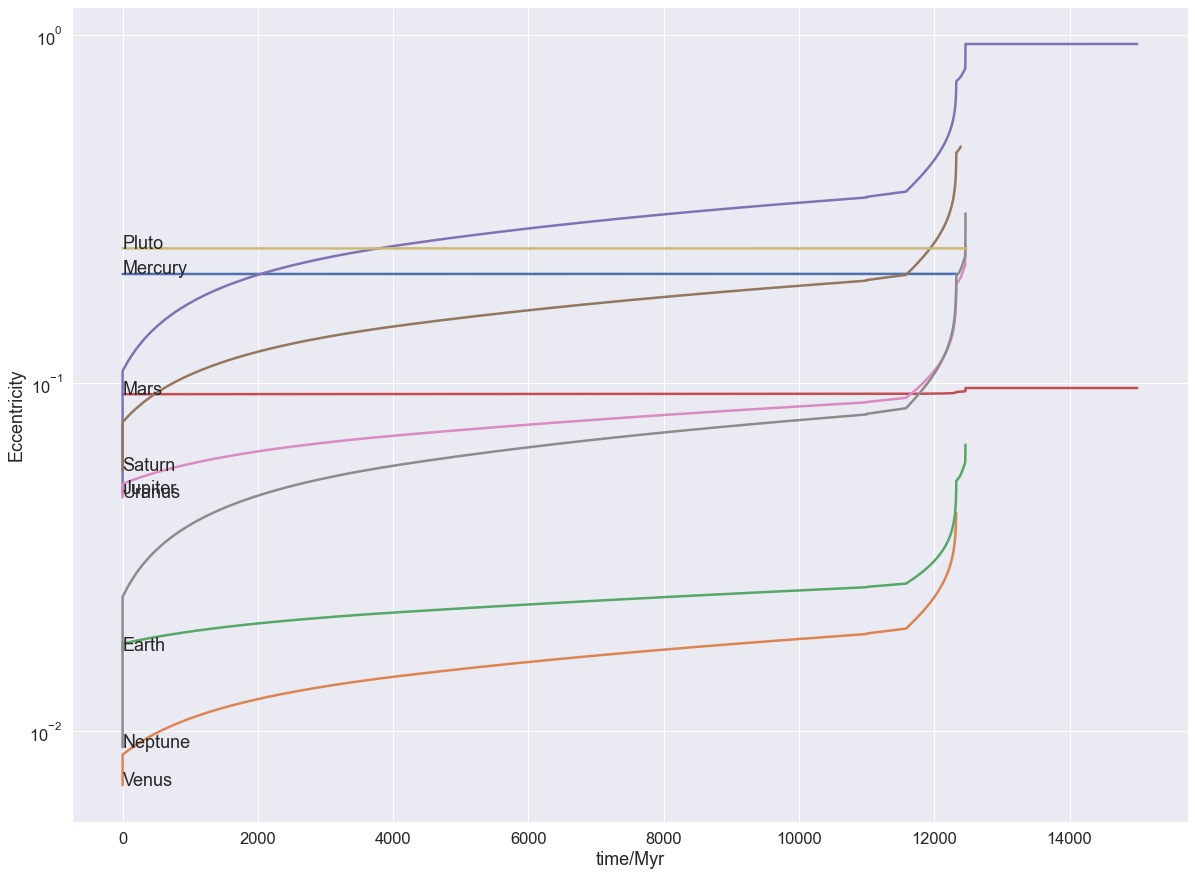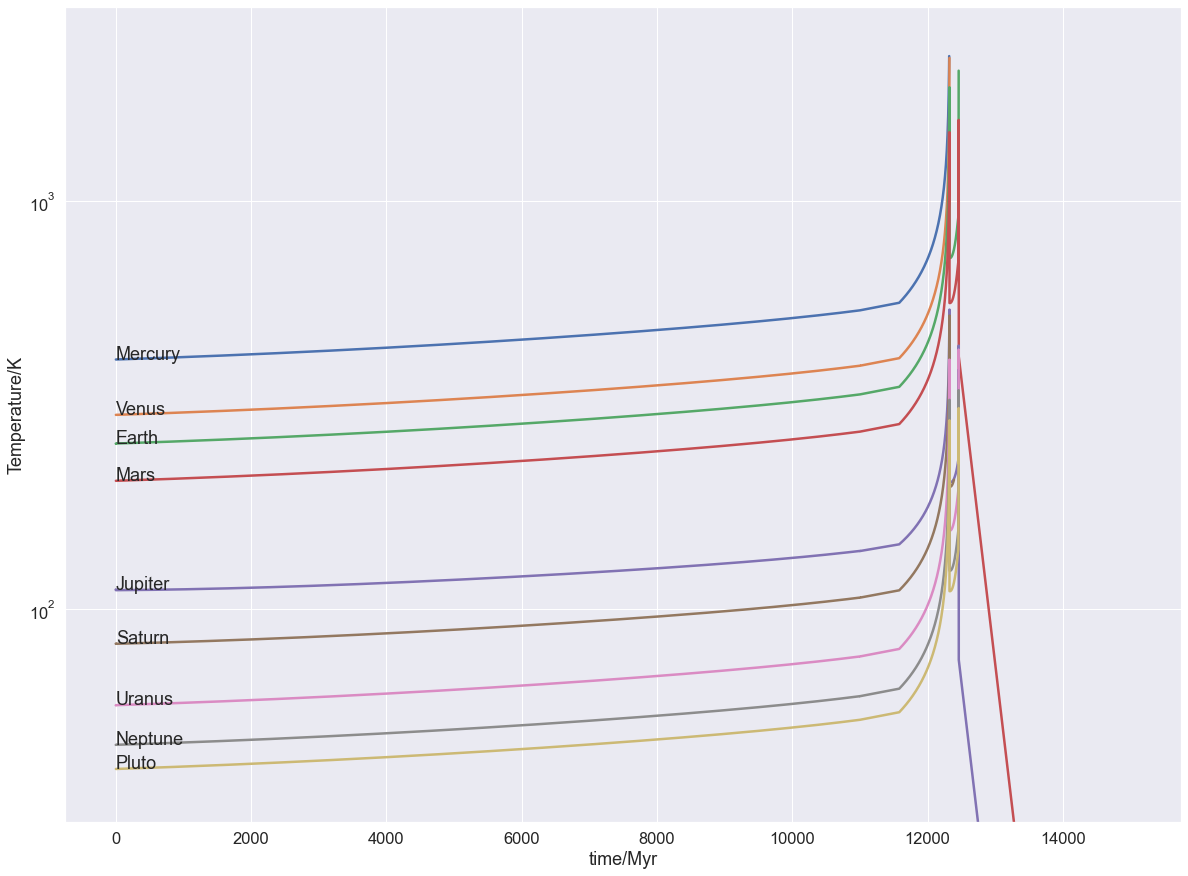Example use case: Solar system using the API functionality
binary_c can evolve orbiting objects, like in our Solar system, during the evolution of the central star. Here we use the API interface to construct a model of the Solar system
[1]:
import os
import re
import math
import matplotlib.pyplot as plt
import seaborn as sns
import pandas as pd
from binarycpython.utils.functions import temp_dir
from binarycpython import _binary_c_bindings
TMP_DIR = temp_dir("notebooks", "notebook_solar_system", clean_path=True)
VERBOSITY = 1
First we must construct the argument string that we pass to binary_c. If you look closely you see we make use of the mass units MMercury etc in this argument string. binary_c recognizes these units, and many more! Moreover, binary_c formats the output for the orbiting objects automatically, so we don’t have to provide a custom logging string.
[2]:
M_1 = 1.0 # Msun
metallicity = 0.02
max_evolution_time = 15000 # Myr. You need to include this argument.
api_log_filename_prefix = TMP_DIR,
orbiting_objects = """\
orbiting_object name=Mercury,M=1MMercury,orbital_separation=1AMercury,orbits=star1,orbital_eccentricity=0.206 \
orbiting_object name=Venus,M=1MVenus,orbital_separation=1AVenus,orbits=star1,orbital_eccentricity=0.007 \
orbiting_object name=Earth,M=1MEarth,orbital_separation=1AEarth,orbits=star1,orbital_eccentricity=0.017 \
orbiting_object name=Mars,M=1MMars,orbital_separation=1AMars,orbits=star1,orbital_eccentricity=0.093 \
orbiting_object name=Jupiter,M=1MJupiter,orbital_separation=1AJupiter,orbits=star1,orbital_eccentricity=0.048 \
orbiting_object name=Saturn,M=1MSaturn,orbital_separation=1ASaturn,orbits=star1,orbital_eccentricity=0.056 \
orbiting_object name=Uranus,M=1MUranus,orbital_separation=1AUranus,orbits=star1,orbital_eccentricity=0.047 \
orbiting_object name=Neptune,M=1MNeptune,orbital_separation=1ANeptune,orbits=star1,orbital_eccentricity=0.009 \
orbiting_object name=Pluto,M=1MPluto,orbital_separation=1APluto,orbital_eccentricity=0.2444,orbits=star1,orbital_eccentricity=0.244 \
orbiting_objects_log 1
"""
# Here we set up the argument string that is passed to the bindings
argstring = """
binary_c M_1 {M_1} metallicity {metallicity} max_evolution_time {max_evolution_time} api_log_filename_prefix {api_log_filename_prefix} {orbiting_objects}
""".format(
M_1=M_1,
metallicity=metallicity,
max_evolution_time=max_evolution_time,
api_log_filename_prefix=TMP_DIR,
orbiting_objects=orbiting_objects
).strip()
output = _binary_c_bindings.run_system(argstring)
print("Printing abridged output:")
print('\n'.join(output.splitlines()[:4]))
print("...")
Printing abridged output:
Object Stars 0.00000000000000000000e+00 0.888249 0
Object 0 Mercury 0.00000000000000000000e+00 CS1 1.65904e-07 0.0293464 83.2303 0.240785 0.206 409.513 26.0946 1053.19 0
Object 1 Venus 0.00000000000000000000e+00 CS1 2.44834e-06 0.60499 155.536 0.61511 0.007 299.567 10.2147 1053.19 0
Object 2 Earth 0.00000000000000000000e+00 CS1 3.00246e-06 0.872269 215.045 1 0.017 254.768 6.28319 1053.19 0
...
There is a lot of data here if you uncomment the print statement!
Let’s split it into a dict of lists of data, one list for each planet, and let’s select only objects that are still orbiting their central star.
[3]:
data = {}
for line in output.splitlines():
match = re.search('Object (\d+) (\S+)',line)
if match:
number = match.group(1)
name = match.group(2)
if not name in data:
data[name] = []
x = line.split()
if x[4] == 'CS1':
x.pop(0) # remove first element of the list "Object" - this is superfluous
x.pop(0) # remove second element of the list "index" - this is superfluous
x.pop(0) # remove third element of the list "name" - this is superfluous (it's the dict key)
x.pop(1) # remove (originally) fourth element "CS1" - this is superfluous (we select this already)
data[name].append(x)
Now convert this data to Pandas dataframes
[4]:
dataframes = {}
for planet in data:
dataframes[planet] = pd.DataFrame(data[planet],
dtype=float, # required! argh!
columns=['time',
'mass',
'angular momentum',
'separation',
'period',
'eccentricity',
'temperature',
'angular frequency',
'spin of central object',
'in disc'],
)
# print (dataframes['Earth']) # Uncomment to print the dataframe
We now make a plot of the separation (distance from the object to the Sun) as a function of time.
[5]:
# set up seaborn for use in the notebook
sns.set(rc={'figure.figsize':(20,20)})
sns.set_context("notebook",
font_scale=1.5,
rc={"lines.linewidth":2.5})
x = 'time'
y = 'separation'
for planet in dataframes:
#print (dataframes[planet])
df = dataframes[planet]
p = sns.lineplot(data=df,
sort=False,
x=x,
y=y,
errorbar=None,
estimator=None,
legend='full'
)
xx = df.head(1).loc[0,x]
yy = df.head(1).loc[0,y]
p.text(xx,yy,planet)
p.set_xlabel("time/Myr")
p.set_ylabel("separation/au")
p.set(yscale="log")
[5]:
[None]

The inner objects are swallowed by the Sun when it becomes a red giant. Earth survives, although mass loss from the red-giant Sun and tides mess with its orbit somewhat. Jupiter is pushed out beyond the orbits of Saturn and Uranus, and this simple model assumes they are ejected in the interaction because Jupiter is (far) more massive. There are options to detect when its orbit is too close to Neptune, and hence possibly eject Neptune, but I’ll let you explore these.
We now construct a plot of the eccentricity or temperature of each planet vs time.
[6]:
# Plot eccentricity
# set up seaborn for use in the notebook
sns.set(rc={'figure.figsize':(20, 15)})
sns.set_context("notebook",
font_scale=1.5,
rc={"lines.linewidth":2.5})
#########
x = 'time'
y = 'eccentricity'
for planet in dataframes:
df = dataframes[planet]
p = sns.lineplot(data=df,
sort=False,
x=x,
y=y,
errorbar=None,
estimator=None,
legend='full'
)
xx = df.head(1).loc[0,x]
yy = df.head(1).loc[0,y]
p.text(xx,yy,planet)
p.set_xlabel("time/Myr")
p.set_ylabel("Eccentricity")
p.set(yscale="log")
[6]:
[None]

[7]:
# Plot Temperature
# set up seaborn for use in the notebook
sns.set(rc={'figure.figsize':(20, 15)})
sns.set_context("notebook",
font_scale=1.5,
rc={"lines.linewidth":2.5})
#########
x = 'time'
y = 'temperature'
for planet in dataframes:
df = dataframes[planet]
p = sns.lineplot(data=df,
sort=False,
x=x,
y=y,
errorbar=None,
estimator=None,
legend='full'
)
xx = df.head(1).loc[0,x]
yy = df.head(1).loc[0,y]
p.text(xx,yy,planet)
p.set_xlabel("time/Myr")
p.set_ylabel("Temperature/K")
p.set(ylim=(30,3000)) # might be necessary?
p.set(yscale="log")
[7]:
[None]

It gets a little toasty on Earth in the not too distant future!